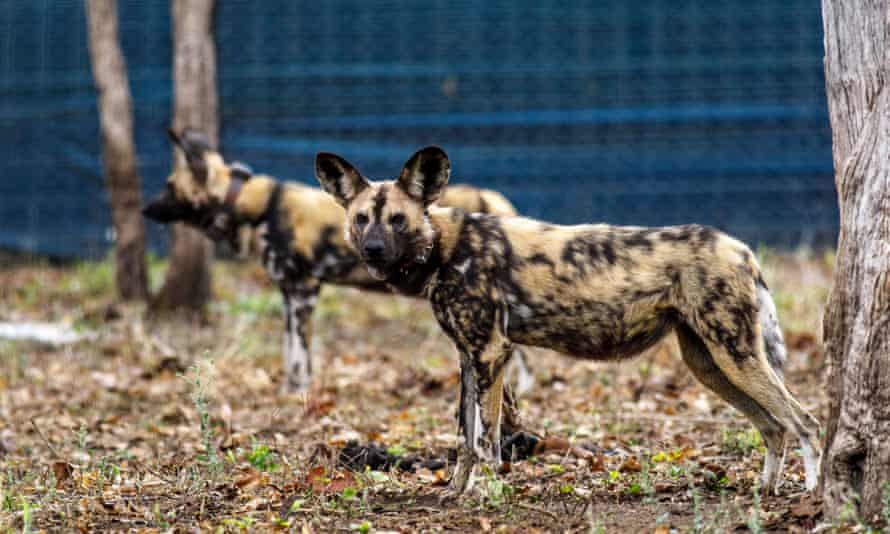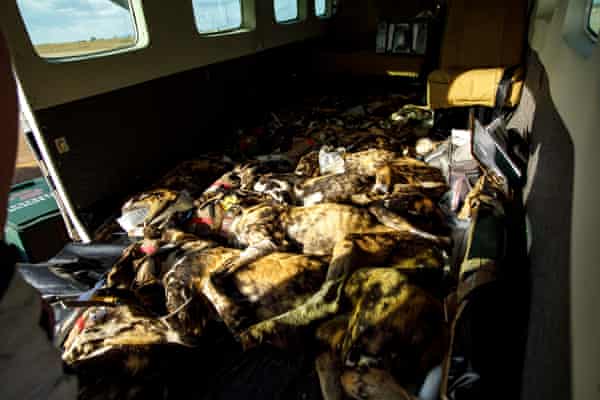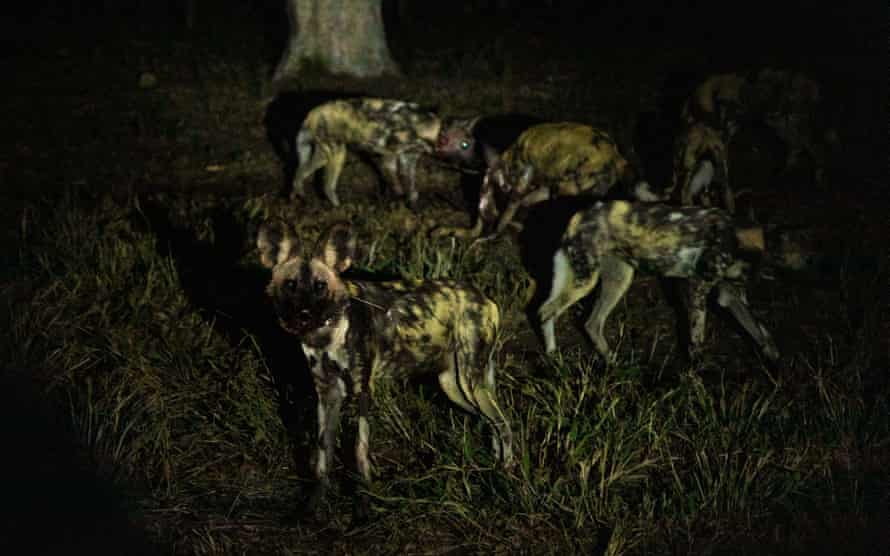Return of the pack: African wild dogs’ epic journey to a new home in Malawi
In an ‘absolute win’ for the endangered species, 14 dogs were transported by road and air to a ‘safe space’ in a country they have not populated in large numbers for decades

Under cover of night, a pack of African wild dogs swarms around an impala carcass. Awake and hungry after a 27-hour transcontinental journey, this animated scene in Liwonde national park is a sign of “mission accomplished”: African wild dogs are back in Malawi.
“The feeling is absolutely surreal and so emotional,” says Cole du Plessis, coordinator of the Wild Dog Range Expansion Project, who this week oversaw the successful translocation of the 14 African wild dogs from South Africa and Mozambique to Malawi’s Liwonde national park and Majete wildlife reserve. “When we flew into Liwonde, on the final leg of the journey, and I saw all the vehicles waiting, I’ll admit I got a bit teary. It’s such an incredible feeling to finally have the dogs here safely.”
As well as helping repopulate both parks, establishing a viable population is part of an international effort to conserve the African wild dog – Lycaon pictus, meaning painted wolf – in the wild. Only an estimated 6,600 individuals are believed to be left on the continent. “Wild dogs are the second most endangered carnivore in Africa [after the Ethiopian wolf] and the most endangered in South Africa,” says Du Plessis. “We only have about 700 breeding pairs left in the whole of Africa. By increasing their safe space, we can increase pack numbers, population numbers and biodiversity. If we don’t intervene, the species will become extinct.”
Although there have been a few sightings in Malawi of wild dogs, and some are known to divide their time between Malawi’s Kasungu national park and Zambia, Du Plessis says there have been no stable established packs of wild dogs in Malawi for more than 20 years, possibly since the 1980s.
The translocated dogs, which include four genetically different groups, were driven in crates, then sedated for the flight to Malawi, before being put in bomas (enclosures) in Liwonde and Majete, where they will settle in for several weeks before being released into their new wild spaces.

The project to bring the dogs to Malawi was a collaboration between the Endangered Wildlife Trust and African Parks, which manages Liwonde and Majete in partnership with Malawi’s department of national parks and wildlife.
The process has been long and fraught; this was the third attempt. After 18 months of planning, the translocation was postponed by several weeks due to Covid-related complications and border closures, then delayed again when unrest in South Africa over former president Jacob Zuma’s arrest led to road closures – a “scary experience”, recalls Du Plessis.
But the bonding of the animals has already gone better than expected. “There’s a little bit of a curveball, in that the alpha females in both packs appear pregnant,” says Du Plessis. “If the females are pregnant, we might release them sooner, to allow time for the pack to find a den and settle before the pups arrive. I can’t wait to see how these wild dogs do in their new homes. I’m absolutely confident they’ll do well.”
Across the continent, African wild dogs have suffered from habitat loss and the effects of human activity. “With development, farming, urbanisation, roads, mining … the more and more you isolate these populations, the more under threat they become,” says Du Plessis. “There are big struggles in Africa with poverty, development and growth, and with that you get new disease, snaring, roadkill.

“Historically, wild dogs have had a cloud of negativity associated with them,” he adds. “They’re very misunderstood … They’ve been persecuted, shot and killed across Africa for decades. But they’re such beautiful and charismatic animals.”
However, thanks to TV documentaries and the animals’ rising popularity among wildlife photographers and safari lovers, their fortunes are changing. “It’s really important to return wild dogs to locations where they’ve been extirpated,” says Dr Angela Gaylard, head of science for African Parks. “Wild dogs are endangered and their populations are declining in most range states. But it’s not just for their conservation value as a species, but also the ecological role that they perform. They’re an important component of the predator guild that helps regulate the population growth of prey species and to maintain stable predator-prey dynamics.”
Since 1998, the Endangered Wildlife Trust’s African Wild Dog Range Expansion Project, supported by the Wild Dog Advisory Group, has implemented reintroductions of African wild dogs across southern Africa.
“African wild dogs need such large distances and large amounts of space. If you look at South Africa, we’re very close to our carrying capacity,” says Du Plessis. “We have such limited safe space for wild dogs in Africa, and Majete and Liwonde, according to our feasibility study, have been identified as optimal wild dog spaces.”
Du Plessis is optimistic for the dogs’ future. “Wild dogs are hardy and intelligent creatures, and usually do very well post reintroduction. We only put animals back where they used to be. It’s about making sure wild dogs are still here in 500 years.”

The wild dogs are being given a helping hand, with the fitting of anti-snare collars and vaccines for rabies and distemper.
The return of the wild dogs is part of a larger transformation for Malawi. African Parks has been working with the country’s authorities since 2003 and has brought black rhinos, elephants, lions, cheetahs and giraffes to Majete wildlife reserve, Liwonde national park and Nkhotakota wildlife reserve.
“Malawi is one of Africa’s brightest conservation stories,” says Samuel Kamoto, African Parks’ Malawi representative. “We’ve translocated more than 4,000 animals of key species over the course of our 18-year partnership with the Malawian government, building secure wildlife sanctuaries with many socio-economic benefits for local people.”
In an often grim picture for global biodiversity, Du Plessis sees the chance to increase the number of wild dogs as a hopeful sign. “Having African wild dogs back in Malawi is incredible for the species, for conservation and for Malawi,” he says. “It’s an absolute win. The work we’re doing now is moving away from conservation and more towards restoration.
“It’s exciting, but we never should have let things get this bad.”
Find more age of extinction coverage here, and follow biodiversity reporters Phoebe Weston and Patrick Greenfield on Twitter for all the latest news and features
